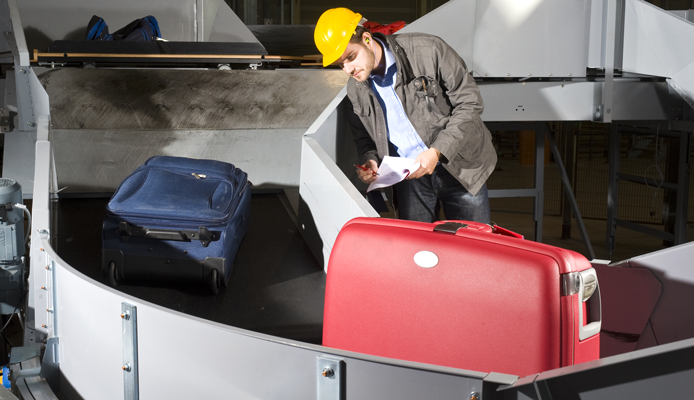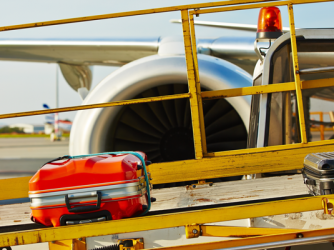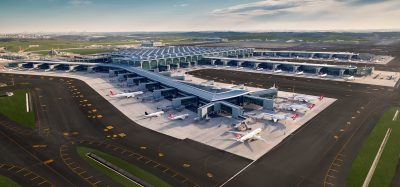Baggage handling: Achieving operational excellence
- Like
- Digg
- Del
- Tumblr
- VKontakte
- Buffer
- Love This
- Odnoklassniki
- Meneame
- Blogger
- Amazon
- Yahoo Mail
- Gmail
- AOL
- Newsvine
- HackerNews
- Evernote
- MySpace
- Mail.ru
- Viadeo
- Line
- Comments
- Yummly
- SMS
- Viber
- Telegram
- Subscribe
- Skype
- Facebook Messenger
- Kakao
- LiveJournal
- Yammer
- Edgar
- Fintel
- Mix
- Instapaper
- Copy Link
Posted: 26 February 2014 | Rien Scholing, Project Manager and Senior Consultant of Logistics, Tebodin Consultants & Engineers | 1 comment
Efficient baggage handling does not necessarily mean mechanisation and automation. Rien Scholing takes a total process view of baggage handling at airports…


Passengers perceive baggage handling as a major contributor to airport and airline quality and with increasing competition in the air transport industry this means continuous pressure to improve the baggage handling process.
Given the highly technical nature of baggage handling systems, it is tempting to focus on technological aspects. However, as this approach concentrates on systems being designed to solve bottlenecks and peak flows, the system can end up being larger and more complex than necessary. A process view focuses on optimising the total process chain, thus preventing bottlenecks from occurring, while smoothing peaks as far as possible.
Handling transfer baggage
While baggage handling at small ‘spoke’ airports is a relatively simple matter, a number of factors make baggage handling at large international airports more complex, which can significantly impact both the costs and quality of services.
Most large international and domestic hub airports handle significant quantities of transfer baggage, which introduces a sorting problem. The sheer volume of baggage handled also raises the risk of congestion, routing errors and control problems. Furthermore in many cases the physical size of the airport dramatically increases transport times to and from the aircraft, leaving less time for the actual sorting and handling of baggage items.
In addition there are usually at least five parties involved in baggage handling, each putting different demands on the process and generating potential conflicts of interests:
- Passengers want a hassle-free process that is fast and reliable combined with short transfers. They also want the freedom to bring a wide range of baggage weights, sizes and shapes
- Airlines want to combine passenger satisfaction and fleet utilisation (turnaround time) at minimum cost. Error rates are important in this respect, as the costs for delivery or damage charges are borne by airlines
- Airports try to achieve maximum quality at moderate investment. Quality is a major factor because passengers tend to attribute errors and delays in baggage handling to the airport. Further to this, the airport is also the owner of the airport space, which is usually scarce and makes additional capacity hard to fit in, especially considering the desired short travelling distances
- Security agents place a strong demand on baggage handling; necessitating in-line screening procedures to handle suspect baggage. Security expects the airport to integrate the in-line security processes and to provide areas for handling
- Handling agents are heavily focused on costs. They expect the airport to provide areas and systems that allow maximum ease of processing.
Speed versus quality
Aircraft turnaround is a major focus for airliners in order to enhance utilisation, but also for passenger satisfaction. The minimum connecting time achievable for transfers is a major element of competition for airlines and is significantly influenced by aircraft turnaround processes.


On the other hand, if these processes are unreliable and poor quality, it could lead to late or misdirected items of baggage, which may cause delays in aircraft departure. If security measures like baggage reconciliation and hold baggage screening are included at a very late stage of the handling chain, or if they have a high false alarm rate, they may well be another important source of delays.
There are several process aspects that are critical for overall baggage handling quality, including:
- The interface between different parties – especially the handover between the baggage handling system and the baggage handler – can be a major source of problems and delays. If not designed well, queues, waiting times and loss of information are common at these points. This also applies to inter-handler processes where incoming baggage has to be transferred from one handler to another and where priority setting of own versus other handler’s baggage is an item
- Efficient item handling. Even when 95 per cent of the baggage is handled at a superior quality level, poor performance on the remaining five per cent of out-of-gauge items can spoil it all
- Speed versus timeliness. A small fraction of time-critical items require fast handling, but the vast bulk merely requires timely handling. Making a clear separation of the two flows and designing processes that are able to achieve both speed and timeliness, depending on the requirements, can help raise quality and reduce costs
- Growth and change are two key elements of the industry. This requires continuous attention on options to extend or change the baggage handling process. Processes and systems that are tailored solely to today’s requirements without some master planning, scenario thinking or sensitivity analysis may be of little use tomorrow.
Cost and quality
Can a baggage handling system be designed to achieve optimum quality and on-time performance at acceptable costs? It’s tempting to design a large and complex system to cope with extreme fluctuations in baggage flow; to cope with the wide variety of baggage dimensions to be handled and because different parties in the process each seek their own optimisation. However these systems can become too complex and large to be effective. A traditional engineering approach will try to solve every problem with a fitting technological solution, leading to sub-optimisation and a process chain that is still bulky, in which case costs are not well-spent.
Focusing on optimisation along the process chain, instead of maximising performance at a single function, can help to overcome this. This requires all participants in the baggage handling chain to collaborate and share information and costs, instead of each trying to achieve their own targets. But process review is also important as, for example, at some larger airports extra valuable space and additional costs are sometimes scarified because every check-in line has its own screening machine.
A second point of note is that most time is not lost in the actual handling of the baggage items but in the waiting times between the various processes, where a handover takes place. This often originates from working with batches of baggage items (such as container loads) instead of single items. Reducing the number of waiting points, extracting time-critical items from a group, and reducing group sizes can be very effective ways to fight this phenomenon.
Much can also be gained from smoothing the peaks in baggage flows. Short but extreme peaks are characteristic of the baggage handling process, but it is important to realise that over 95 per cent of the baggage items in that peak could be delayed for several minutes without any significant effect on the overall quality of service. Finding ways to identify non-time critical items and handle them off-peak can reduce the required capacity of the baggage handling system.
The estimated cost of mistakes and delays should also be taken into account when baggage handling options are being evaluated. A cheaper system that generates just a fraction more misdirection of baggage can prove to be much more expensive in the long run. For example, a baggage item that does not catch its intended flight can cost some $100 or more in extra handling and delivery charges.
Considerations like these were used in the development of the ‘Just In Time’ concept which is mostly found in the production industry, but which could be adapted for the baggage handling process.
Forecasts and design
In view of the growth rates at most major airports, baggage handling systems have to be extended and redesigned frequently to ensure they can cope with throughput requirements. Proper timing and anticipation is essential for this and can only be achieved through the regular updating and reviewing of passenger and baggage flow forecasts, plus peak rates and connection times associated with them.
Sufficient spare capacity should also be made available to allow for temporary shut-down of lines needed to interconnect existing and new facilities. Such flow evaluations should be carried out for the entire baggage handling chain to prevent unrealistic quality and throughput targets being used between different parties and to develop knowledge into the room for improvement in existing processes.
When detailing the design of the baggage handling system, static capacity and forecast analyses are often insufficient. More insight is required into system behaviour during peak loads such as queuing effects and waiting times, and the impact of flight schedule changes.
Computer simulation offers an excellent tool to perform such dynamic testing, but is not as simple as it may seem. A good model will not only provide insight in the overall system performance during various operational modes, but can also pinpoint potential bottlenecks and system control problems already at the design stage.
Manual labour versus automation and mechanisation
There is an enormous variation in the degree of automation and mechanisation of the baggage handling process at different airports around the world. The choice of whether or not to automate is influenced by various things including the local costs of manual labour, labour regulations, the confidence in technique – which itself is related to the quality and dedication of local personnel – and the division of roles between airport operator, ground handler and the airline. A number of arguments for both choices can be distinguished:
In favour of automation:
- Better control
- Cheaper to operate if there is a large volume
- Fewer and more predictable mistakes
- Predictable performance
- Reduce heavy labour conditions
- Fewer problems with labour disputes
- Can be faster.
In favour of manual handling:
- Lower capital investment costs
- Easy to extend or expand
- Less space needed in terminal
- More flexible with exceptional sized baggage and ‘rush’ handling.
For the larger airports in Western Europe, the scale will tilt towards a relatively high degree of automation. However, it is not necessarily a good idea to automate all flows and peak situations. Instead, opportunities to use manual processes for an ‘overflow’ during peaks can be built into the process design.
Assess bag handling techniques
Baggage handling is traditionally a technology-dominated market. In fact, new technologies developed and marketed by specialised suppliers often trigger a new baggage handling process set up, instead of the other way around. We believe that attention to the specific characteristics of baggage items is somewhat overemphasised as specialist baggage handling equipment is combined with technologies and concepts proven for other non-baggage applications. For example:
- The application of standard trays, carriers or vehicles for individual baggage items not only helps identification during various process steps and adds uniform handling properties to the items. This allows the application of a wide range of other available handling systems that are not normally suited for baggage handling
- Storage of early baggage is still often done in batches of items with the same destination or departure time. Applying conventional warehousing technology to this process can often render a much more efficient use of space, and opens up an enormous potential for flow levelling and priority control
- Pull control on baggage item routing can make the overall process more efficient. As opposed to the push control that takes controlling complexity as a starting point and results in definition of different functions and complex planning systems, pull control takes simplicity as a starting point. The pull concept is a Japanese production system, which employs the mechanics of the so-called ‘kanban control logic’ and ‘Just In Time’ principles. The pull concept is more common in industrial production environments. For baggage handling it would mean that flows are not primarily dependent on input but are regulated on the basis of the desired output criteria
- A new baggage label design could be an enormous asset to the baggage handling process. Ideally, the label should support optimum control e.g. to have location information of the item at any moment during the process and by having more shared and bar-coded information about routing. Radio frequency identification gives technical possibilities and also new developments like the permanent tag and the self-printed tag are interesting developments here
- Improving labour conditions. Special techniques such as lifting aids are developed that can be easily integrated into the process and that, even more important, are perceived by operators as true support. A must in countries with high labour standards, but also in developing countries this will become an issue.
These concepts will provide new opportunities to achieve higher capacities in existing terminals where extensions are too problematic, e.g. in Europe and America. New airports and terminals have the chance to take these logistic improvements and learning points from other industries directly into the new design.
There are a few possibilities for new developments and improvements, including:
Process integration
The most promising – but probably the hardest – option for upgrading the handling process is to take a true supply chain approach to baggage handling and try to avoid queues, double handling and sub-optimisation. Important factors in this respect are the sharing of information between parties, full cooperation in design and in the execution of the total process and dedication and process ownership with the personnel.
Aircraft loading and unloading
Considerable improvements in the actual loading and unloading of baggage to and from the aircraft are possible. This is especially true for non-containerised baggage.
Automation of baggage container transport
Small scale systems for automatic container transport have been installed at various airports. Transport systems inside and outside the buildings can be expected in the long run.
Redesign of the baggage reclaim process
Taking the passengers’ perspective, baggage reclaim is clearly an underdeveloped area – would it not be logical to upgrade this function to the quality level of the check-in process? Can baggage loading/unloading times be reduced to only a fraction of the present turnaround times? Are quality improvements and cost reductions feasible despite growth of airport size and baggage flow quantities? Are new and better baggage handling products feasible and can they be properly supported by systems and processes?
The answer to all these questions is ‘yes’. There is ample potential for improvements and time and cost savings. However, this requires true willingness of parties to cooperate and rethink the baggage handling process together to develop into a system which can cope with ever-growing baggage flows.
Does this mean that handling will one day be reduced to a fully-automated and mechanised function? No. Relying on solely technical systems for baggage handling would be both unrealistic and expensive. Man is still the most powerful and flexible resource available and baggage systems are effective tools to handle the routine processes.
About the author
Rien Scholing is Project Manager and Senior Consultant of Logistics at Tebodin Consultants & Engineers. Rien has gained experience in the field of logistics during more than 15 years, both as consultant and as project manager in various markets including air and marine ports and distribution and production companies. Rien has also previously been Project Manager in the field of information management and environment and safety. Rien also holds an MSc in Physics.



















The baggage handling system market is estimated to be valued at USD 6.45 Billion in 2015. It is projected to grow at a CAGR of 7.72% to reach $9.36 Billion by 2020.
Get Free Sample PDF Brochure : http://www.marketsandmarkets.com/pdfdownload.asp?id=955
Baggage handling process is the coordination and collection of activities, such as bag check-in, tagging, screening, transporting, sorting, and storing of baggage. The baggage handling system helps to transport passenger bags from the check-in area to the departure gate, and vice-versa, and thus, serving an airport by improving its operational efficiency.